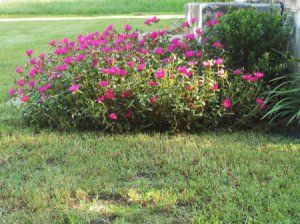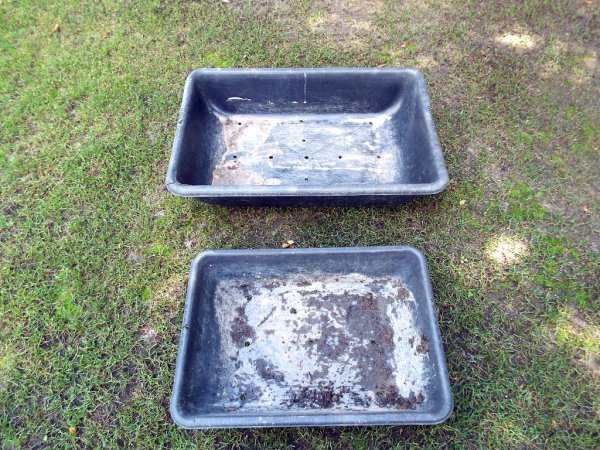 With Bermuda grass growing all around, it was impossible to keep it out of the lawn. Eventually, all the fescue was removed and a fine bladed Bermuda hybrid was planted.
With Bermuda grass growing all around, it was impossible to keep it out of the lawn. Eventually, all the fescue was removed and a fine bladed Bermuda hybrid was planted.
Bermuda migrates towards wetter soil. If flower beds are kept wetter than the surrounding lawn, Bermuda will easily invade them. Using sunken concrete mixing tubs as liners for beds can prevent this migration, underground. Keeping above ground migration at bay is much easier.

A hole is dug to accommodate the tub. Plastic is used to line the bottom of the hole. The plastic prevents underground grass roots from growing up through drain holes which were cut into the tubs. Saved fertilizer or potting soil bags are ideal for this purpose.
The tub is placed in the hole, being leveled by the addition or removal of small amounts of underneath soil, here and there. The soil is adjusted so that the rim of the tub will extend about one half inch above the surrounding soil. The lawnmower can then mow over the rim, where necessary. The tub is then filled with a soil rich in organic matter or a soil amended to suit a particular type bedding plant.
The soil can be easily removed from these tubs yearly and replaced with fresh. More often, all that is needed is the addition of a layer of nutrient rich compost to serve as a top dressing.
Pictured is a small bed of purslane. It is being grown in a sunken concrete tub. To the casual observer, it appears the flowers are being grown directly in the ground. Liriope (monkey grass), can be seen to the right of the purslane. It is one of a row of liriope plants being grown in sunken pots. When the first heavy frost has killed the purslane, it will be replaced with pansies or viola to provide a display of color throughout winter and well into spring.
Using mixing tubs to containerize small flower beds has many advantages. Weeding is much easier. Water is conserved. Invading grass can be more easily controlled. There is a fixed, neat appearance.
Once sunken, these tubs will last for many years. They are low cost and readily available in at least two sizes from home and garden centers such as Lowe's and Home Depot. The only preparation would be the cutting of several quarter size drain holes.
Steps:
How can I keep grass and weeds out of my flower bed? I have a beautiful flower bed and am having trouble keeping the weeds manageable. this is a direct sunlight area. What products do you suggest we use?
How can I safely get rid of weeds in my flower beds?
Wilda Scott
I hate weeds! But something that helps, try spreading black plastic around the plants ( under the mulch), or you might try shredded newspaper under the mulch.Either helps out.
Put half white vinegar & half water in a spray bottle & spray on the weed, but stay away from any flowers! Boiling water also works.
You can also buy this stuff called preen.
I always use a generic version of Preen. It is a weed preventer not weed killer. You must read the directions. You get all the weeks and grass out and work up the soil. Then spred the product on the soil. Then you must work it in slightly with a rake or I just go along and do it with my hands (wearing garden gloves). It is then suppose to be wattered. But I sometimes don't do this. It does not prevent all weeds from germinating but helps alot.
Pour table salt all over them and then pour white vinegar on top of the salt - do this on a really hot, sunny day and they will not last long!
Editor's Note: This will kill weeds but could also kill your flowers. A little salt 1 tbsp. in 1 gallon of vinegar with about 1/2 tsp of dish soap then sprayed on the weeds on a hot sunny day will kill just the weeds. Make sure you only spray it on the weeds.
Take a hoe and dig them out. Its good exercise and its better not to use pesticides around anyway. My gardens are beautiful and I'm retired.
I tried boiling water some time back, and it definitely works, but there's a problem. You'll kill the earthworms!
Last year, I got pieces of cardboard wet (soak them with water), and cover the weeds with them.
If you have bare dirt and enough room between your plants, a hoe will cut off seedlings below the ground and they won't come back. I find a Hula Hoe (or wiggle hoe) more fun and easier to use, but it offers less control, so I don't use it close to my desired plants.
For bindweed, which comes back no matter how deep I dig it, I take a cheap artist's paint brush and brush Round-up generously on all the leaves on a sunny day. The Round-Up (or equivalent) is taken up by the leaves and drawn down to the roots, where it (hopefully!) will kill the weed, without harming its neighbors. I don't like using poisons, but I think this is an appropriate time to use it judiciously.
I agree with momma red and KBlueyes. I cover the area with either plastic, or cardboard or rocks. It kills weeds and grass underneath without getting nasty chemicals in your ground water which eventually goes to your waterways, the fish, and your drinking water. Studies are showing that municipal filtration does not remove many chemicals, so we have to think about what we use in the soil and garden. There is a trend toward encouraging "rain gardens" to filter water going to waterways. No chemicals should be used.
Now you truly have a "clean slate" with which to work. Remove the plastic and lay down landscape fabric.
How do I stop weeds in my flower beds? I pull them up, turn the soil over, and within two weeks they are back with vengeance.
By Nix from England
Is there any weed and feed that can be sprayed on flower beds?
By moucheninette from Perth, TAS
What can I do? I have lots of weeds with my flowers. What can I do to get rid of the weeds, but not flowers?
By Gail
The thistles in my flower garden are certainly competing with the flowers this year. If I were trying to grow thistles, I'd be quite successful! What can I use to get rid of these pesky plants that won't harm the good flowers and our pets?
By Lois C.
I am having trouble with kosha weeds and sunflowers taking over my wildflower garden patch. Are there any other alternatives to hand weeding?
By Krys
This is a page about keeping grass from growing in a flower bed. Weed grass seeds can be carried by the wind, birds or be already in your soil ready to sprout when they get water.
Being elderly, we are finding keeping on top of weeding flower beds is getting beyond us. We are wanting to cover a large raised bed with some sort of gravel, on top of weed control blanket, then we shall put some decorative shrubs in. Can anyone advise on whether we should use pea shingle or gravel. We are told that stone chippings will become covered in algae, hence a leaning to gravel. Any advice would be greatly appreciated.
By Ann Y